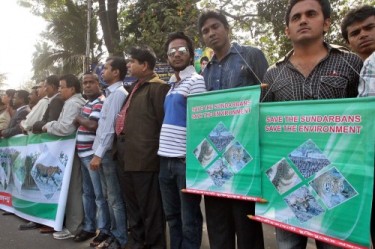There are less than 3200 wild tigers across the world. To save them and protect their natural habitats, 13 nations including Bangladesh, India, Indonesia, China, Bhutan, Nepal, Mianmar, Thailand, Malaysia, Cambodia, Laos, Vietnam and Russia observe Global Tiger Day on the 29th of July each year. This year the slogan for the day in Bangladesh was – ‘Save Sundarbans Tiger Landscape‘.
The main reserve for the Royal Bengal Tiger is the Sundarbans Mangrove Forest. Several attempts to conserve the tigers did not work and the tiger population is decreasing day by day. Since 1980, 65 tigers have died in Sundarbans because of poachers, attacks by villagers and natural disasters. Between 1980-2000, 33 died. In the past decade (2001-2011) alone, 32 tigers have died.

The tiger came to a village to find food. It attacked three villagers and was eventually killed by the villagers. Image by Sheikh Mohiruddin. Copyright Demotix.
Experts say that perils exist at every step for these tigers, be it the nets of poachers, bullets of hunters, tidal surge, or the ignorance of local people. They often wander into villages near the forest to find food and never make it back to their habitat. A recent report suggests [bn] that on average each year three tigers die due to poaching, old age, shortage of food and natural disasters. According to the 2004 census done by the World Bank, the tiger population of the Sundarbans was 440. Of them 121 were male tigers, 298 female tigers and 21 were cubs.
So far the ‘National Tiger Recovery Program’ has been launched and the 2009-2017 tiger conservation plan is being implemented. The government has enacted the Bangladesh wildlife act 2012 with tougher punishment for tiger and deer poaching.
On the other hand 140 fishermen, woodcutters and villagers died in last four years (2008-2012) due to attacks by tigers inside the forest and in other localities. Thirty-two people were injured. Blogger Meftu informed [bn] on Global Tiger Day that people have died in his village from tiger attacks.
Blogger Irene Sultana on [bn] why the tigers are being poached:
বাঘ মেরে ফেলে কেবল চামড়া বেচলেও কড়কড়ে নোটের নগদ ‘১৫ লাখ টাকা’ কামিয়ে নেওয়া যায়। বিশ্বের প্রায় ৪০টি দেশে রমরমা ব্যবসা রয়েছে বাঘের চামড়া ও অন্যান্য অঙ্গপ্রত্যঙ্গের। সবচেয়ে বড় বাজারটি নিয়ন্ত্রণ করে চীনের ঐতিহ্যবাহী ওষুধশিল্প। এভাবে শিকারি বাঘ নিজেই শিকারে পরিণত।
Sundarbans Mangrove Forest constitutes 41% of total conserved forest areas of Bangladesh. The diverse reserve boasts of a habitat of 453 species of animals including many endangered species. This forest also acts as an shield to the coastal population of the Bay of Bengal especially in the time of natural disasters such as cyclones and tidal surges. A portion of the forest was declared as Ramsar conservation site on the 21st May of 1992. Later in 1997 UNESCO had declared the Sundarbans as a World Heritage Site.
Now Sundarbans is the only habitat for the Royal Bengal Tiger. But the reservation area is decreasing day by day. Natural disasters are creating an imbalance in the local ecosystem. Two centuries ago Sundarbans had a total area of 16,700 square kilometer. But the area has since been reduced to one third. So this year, on Global Tiger Day, the participants were calling to save the Sundarbans. Protests were made against the construction of a coal-based power plant project near the forests. The Bangladesh government, in collaboration with India, has signed an agreement [bn] to build a coal powered power plant in Rampal, near Sundarbans.

Human chain protest against construction of a coal based power plant project near Sundarbans. Image Firoz Ahmed. Copyright Demotix.
Dinmozur informs [bn] how this proposed power plant will endanger Sundarbans:
পরিবেশ দূষণ, লবণাক্ততা, জলবায়ু পরিবর্তন, বন কেটে ধ্বংস করা ইত্যাদি নানান কারণেই বাংলাদেশের প্রাকৃতিক ঐতিহ্য সুন্দরবন ধ্বংসের মুখে। প্রস্তাবিত কয়লা বিদ্যুৎ কেন্দ্রটি থেকে সুন্দর বনের দূরত্ব মাত্র ৯ কিমি। ফলে কয়লা বিদ্যুৎ কেন্দ্রের মাধ্যমে বায়ু-পানি-কঠিন-তরল যত ধরণের দূষণ ঘটতে পারে তার সবটুকুই সরাসরি সুন্দরবনকে ক্ষতিগ্রস্ত করবে।
Kamrul Hasan also mentions [bn] the environmental disaster the power plant can cause:
কয়লাভিত্তিক বিদ্যুৎকেন্দ্রে যে পরিমানে কোল ডাস্ট বা কয়লা ধুলোর সৃষ্টি হবে তা সুন্দরবনের বাতাসে মিশে জীব বৈচিত্র্যে উপর মারাত্মক বিপর্যয় ডেকে আনবে। কার্বন নিস্রনের পরিমাণ বেড়ে গেলে বাতাসে সীসার পরিমাণ বেড়ে যাবে। ফলে কম সহনশীল প্রাণী টিকিয়ে থাকার প্রতিযোগিতায় পিছিয়ে পড়বে।
In a report by Transparency International Bangladesh, a letter from the Chief Conservator of Forests of Bangladesh was quoted, where he said: “If this coal based power plant is built near Sundarbans out in the open, it will endanger the diverse wildlife in the Sundarbans including the Royal Bengal Tiger”.







1 comment
The Sundarbans in Bangladesh, which is home to the Royal Bengal Tiger and many other species is being threatened. Only 350 tigers remain in this UNESCO mangrove forest.
Please sign this petition and spread the word.
https://secure.avaaz.org/en/petition/Save_Sundarbans_Stop_Rampal
It is to stop the construction of a COAL PLANT 14 km away from the Sundarbans in Bangladesh. This coal plant was not allowed to be built in India many times as it violated their strict environmental laws, however, the Indian PM and the Bangladesh PM are taking advantage of the lax Bangladeshi laws to build this. A similar Texas plant caused much destruction to the environment.
http://world.time.com/2013/09/26/how-not-to-love-nature-shove-a-coal-plant-next-to-earths-biggest-mangrove-forest/